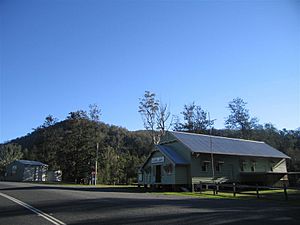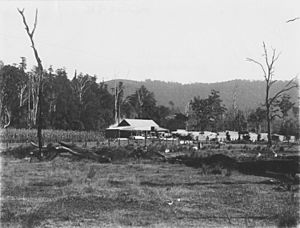Numinbah Valley School of Arts facts for kids
Quick facts for kids Numinbah Valley School of Arts |
|
|---|---|

Numinbah Valley School of Arts, 2007
|
|
| Location | Nerang–Murwillumbah Road, Numinbah Valley, City of Gold Coast, Queensland, Australia |
| Official name: Numinbah Valley School of Arts | |
| Type | state heritage (built) |
| Designated | 7 December 2007 |
| Reference no. | 602419 |
| Significant period | 1925– |
| Lua error in Module:Location_map at line 420: attempt to index field 'wikibase' (a nil value). | |
The Numinbah Valley School of Arts is a special old building located on Nerang–Murwillumbah Road in Numinbah Valley, Australia. It's a single-story timber building that was built in 1925. This building is important because it has been a central meeting place for the community for many years. It is listed on the Queensland Heritage Register, which means it's protected for its historical value.
Contents
A Look Back at the Numinbah Valley School of Arts
The Numinbah Valley School of Arts was built in 1925. It's made of timber and stands on stumps, with a corrugated iron roof. Over the years, parts of the building were added in 1937, 1960, and 1981. When you enter the Numinbah Valley area, it's one of the first buildings you see on the right side of the main road.
How the Valley Grew
The Numinbah Valley is a beautiful area surrounded by cliffs and forests. It's located in the Gold Coast Hinterland. In the 1870s, people started settling here. They came looking for valuable red cedar trees. Later, the Queensland Government opened up the land for more settlers.
Farming became important in the valley. People raised dairy cows, grew bananas, and produced beef and pigs. The valley was quite isolated at first. It wasn't until the early 1900s that a road connected it to Nerang. This road was very important for farmers to transport their goods quickly.
A family named Yaun started a sawmill in the Numinbah Valley around 1909. This sawmill helped the local economy and provided jobs. It operated until it was destroyed by fire in 1944.
Building a Community Hub
For many years, people in Numinbah Valley held social events in barns or open fields. In 1915, Lillian Mary Yaun suggested getting land for a community hall. After some discussions, the community agreed to help pay for the land. In 1916, a piece of land was set aside for a "School of Arts."
By 1923, the community really needed a proper place for social gatherings. So, in 1925, everyone worked together to raise money. They held events and collected donations. Local people even donated timber from their own land. The Yaun Bros. sawmill, which was nearby, processed the timber for free.
Cyril Duncan built the Numinbah Valley School of Arts hall for about £100. This price even included the roofing iron and nails!
What is a School of Arts?
"Schools of Arts" or "Mechanics' Institutes" first started in Britain in the early 1800s. Their main goal was to help people learn and grow. They offered lectures, discussions, and libraries where people could borrow books. Back then, books were expensive, and there were no public libraries. So, these places were very important for education and entertainment.
The idea spread to Australia. The first one in Queensland was set up in Brisbane in 1849. Soon, many towns across Queensland had their own School of Arts. These buildings often had a hall and a few rooms for libraries and meetings. They became key places for adult education and community events.
The Hall Opens
The Numinbah Valley School of Arts officially opened in September 1926. It was a single-story building with weatherboard walls. It measured about 50 feet by 25 feet. It had a corrugated iron roof and a smaller roof over the entrance porch. Inside, there was a stage at the back with a room on each side. The floor was made of special timber, which was great for dancing!
A School in the Hall
In 1926, parents in Numinbah Valley asked if the School of Arts could be used as a provisional school. At that time, the government didn't fully fund schools in small communities. So, local communities often had to set up and pay for their own schools.
On February 7, 1927, the Provisional Numinbah School opened in the School of Arts building. There were 16 students. The Queensland Government provided some help, like a teacher's salary and approved books. However, the community had to provide the building and a place for the teacher to live. The school used the hall until a new, purpose-built State School opened in October 1934.
Changes Over Time
As the valley grew, the School of Arts also changed.
- 1937: The hall was made bigger. A 25-foot extension was added to the back, creating more space for dancing and concerts. The front entrance was also changed to add changing rooms.
- Early 1960s: A veranda was built on the side of the hall, adding more seating and a supper area. The local QCWA (Queensland Country Women's Association) helped raise money for this. Electricity came to the valley in 1961, so kerosene lamps were replaced with electric lights. A kitchen was also installed in 1962. The front entrance was changed again, with one room becoming a ticket office and the other a mother's room.
- 1975: Locals celebrated the hall's 50th birthday. An article mentioned its green painted gable with elegant fretwork. It was noted that the hall was used for weddings, dances, and church services.
- 1981: An open annex with a corrugated iron roof was added along one side.
- 1983-1984: A bar was built in the supper room, and the hall was repainted. A prisoner even painted Australian-themed murals in the bar area.
The Numinbah Valley School of Arts has always been a much-loved community building. It continues to be used for social events, recreation, and learning, just as it was intended.
What the Building Looks Like
The Numinbah School of Arts is a single-story timber building that stands on stumps. It has a double-gabled roof made of corrugated iron. It faces the main road that connects Nerang to Murwillumbah.
The main part of the building is rectangular. There's a small entrance porch under a lower gable roof. On the left side, there's an enclosed veranda with a hipped roof. On the right side, there's an open-air annex. You enter the building through the front porch.
The gables (the triangular parts of the roof) have decorative fretwork. Above the main entrance, a large sign says "Numinbah Valley School of Arts." Inside the entrance porch, there's a ticket office on the left and another room on the right.
On the northern side, there are two doors leading into the hall. The sub-floor at the back of the building has been closed in. Large water tanks collect water for the hall.
Outside, a timber fence separates the hall from the road on the northern side. This area is like a park and has been used for sports days and picnics.
Why This Place is Special
The Numinbah Valley School of Arts was listed on the Queensland Heritage Register in 2007. This means it's recognized as an important historical place.
A Piece of Queensland's Story
This building shows how Queensland's history developed. Many towns in Queensland had a School of Arts, and they often showed how well a town was doing. The Numinbah Valley School of Arts is a great example of a community-built hall that is still used today. It has been a place for many activities since 1925, including school classes, dancing, church services, and community meetings. It has also been home to groups like the local QCWA. It's a key part of the Numinbah Valley community's social life.
A Typical School of Arts Building
The Numinbah Valley School of Arts is a good example of a community hall built for the "School of Arts" movement in Queensland. Most of its original features are still there.
Beautiful and Important
The building has a simple, balanced design with decorative fretwork on the front. It looks great in the rural landscape of Numinbah Valley. As a well-designed timber building, it adds a lot to the character of the area. It also stands out as a landmark because it's a large building located right on the main road through the valley.


